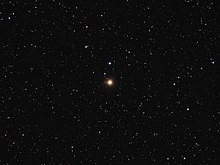5 Lacertae
| Observation data Epoch J2000 Equinox J2000 | |
|---|---|
| Constellation | Lacerta |
| Right ascension | 22h 29m 31.823s[1] |
| Declination | +47° 42′ 24.79″[1] |
| Apparent magnitude (V) | 4.36[2] |
| Characteristics | |
| Spectral type | K6–M0I + B7/8V[3] |
| U−B color index | +1.11[2] |
| B−V color index | +1.68[2] |
| Variable type | LC[4] |
| Astrometry | |
| Radial velocity (Rv) | −3.4±0.2[5] km/s |
| Proper motion (μ) | RA: −2.554 mas/yr[6] Dec.: −5.372 mas/yr[6] |
| Parallax (π) | 1.4838 ± 0.1383 mas[6] |
| Distance | 2,170+200 −180 ly (665+62 −54 pc)[7] |
| Orbit[5] | |
| Period (P) | 41.95±0.20 yr |
| Eccentricity (e) | 0.49±0.01 |
| Periastron epoch (T) | 2427578.3±260 JD |
| Argument of periastron (ω) (secondary) | 323±5.0° |
| Semi-amplitude (K1) (primary) | 12.2±1.2 km/s |
| Semi-amplitude (K2) (secondary) | 112.0±8.2 km/s |
| Details | |
| 5 Lacertae A | |
| Mass | 5.11±0.18[8] M☉ |
| Radius | 359[9] R☉ |
| Luminosity | 25,100[9][a] L☉ |
| Temperature | 3,790[9][b] K |
| Rotational velocity (v sin i) | 50[10] km/s |
| Age | 110±10[8] Myr |
| 5 Lacertae B | |
| Rotational velocity (v sin i) | 89[2] km/s |
| Other designations | |
| Database references | |
| SIMBAD | data |

5 Lacertae (5 Lac) is a spectroscopic binary in the constellation Lacerta. Its apparent magnitude is 4.36.

5 Lacertae is a slow irregular variable star with a small amplitude. Photometry from the Hipparcos satellite showed brightness changes between Hipparcos magnitudes 4.39 and 4.56 with no clear periodicity.[4] It was given the variable star designation V412 Lacertae in 1999 in a special name-list dedicated to variables detected from Hipparcos.[13]
The spectrum of 5 Lacertae clearly indicates both a hot component and a cooler component, recognised even in early spectra. Published spectral types for the brighter cool component vary from K4 to M0, with a luminosity class of giant or supergiant. The hotter star is generally classed as a relatively unevolved late B or early A star, but an automated classification program gave it a spectral class of B2V.[14]
Radial velocity variations in the absorption lines from the two separate stars have been measured to determine the orbit. This has an unusually long period of almost 42 years. The two stars have an eccentric orbit with a projected axis of about 15 au.[5]
Notes
[edit]References
[edit]- ^ a b van Leeuwen, F. (2007). "Validation of the new Hipparcos reduction". Astronomy and Astrophysics. 474 (2): 653–664. arXiv:0708.1752. Bibcode:2007A&A...474..653V. doi:10.1051/0004-6361:20078357. S2CID 18759600.Vizier catalog entry
- ^ a b c d Hoffleit, D.; Warren, W. H. (1995). "VizieR Online Data Catalog: Bright Star Catalogue, 5th Revised Ed. (Hoffleit+, 1991)". VizieR On-line Data Catalog: V/50. Originally Published in: 1964BS....C......0H. 5050. Bibcode:1995yCat.5050....0H.
- ^ Pantaleoni González, M.; Maíz Apellániz, J.; Barbá, R. H.; Negueruela, I. (2020-01-01). "A Catalog of Galactic Multiple Systems with a Red Supergiant and a B Star". Research Notes of the American Astronomical Society. 4 (1): 12. arXiv:2001.11680. Bibcode:2020RNAAS...4...12P. doi:10.3847/2515-5172/ab712b. ISSN 2515-5172.
- ^ a b Samus, N. N.; Durlevich, O. V.; et al. (2009). "VizieR Online Data Catalog: General Catalogue of Variable Stars (Samus+ 2007-2013)". VizieR On-line Data Catalog: B/GCVS. Originally Published in: 2009yCat....102025S. 1. Bibcode:2009yCat....102025S.
- ^ a b c Hendry, E. M. (1978). "Observations of a second maximum for the very long period spectroscopic binary 5 Lac". Publications of the Astronomical Society of the Pacific. 90: 184–187. Bibcode:1978PASP...90..184H. doi:10.1086/130304.
- ^ a b Vallenari, A.; et al. (Gaia collaboration) (2023). "Gaia Data Release 3. Summary of the content and survey properties". Astronomy and Astrophysics. 674: A1. arXiv:2208.00211. Bibcode:2023A&A...674A...1G. doi:10.1051/0004-6361/202243940. S2CID 244398875. Gaia DR3 record for this source at VizieR.
- ^ Bailer-Jones, C. A. L.; Rybizki, J.; Fouesneau, M.; Demleitner, M.; Andrae, R. (2021-03-01). "Estimating distances from parallaxes. V: Geometric and photogeometric distances to 1.47 billion stars in Gaia Early Data Release 3". The Astronomical Journal. 161 (3): 147. arXiv:2012.05220. Bibcode:2021AJ....161..147B. doi:10.3847/1538-3881/abd806. ISSN 0004-6256. Data about this star can be seen here.
- ^ a b Baines, Ellyn K.; et al. (2018). "Fundamental Parameters of 87 Stars from the Navy Precision Optical Interferometer". The Astronomical Journal. 155 (1). 30. arXiv:1712.08109. Bibcode:2018AJ....155...30B. doi:10.3847/1538-3881/aa9d8b. S2CID 119427037.
- ^ a b c Healy, Sarah; Horiuchi, Shunsaku; Molla, Marta Colomer; Milisavljevic, Dan; Tseng, Jeff; Bergin, Faith; Weil, Kathryn; Tanaka, Masaomi (2024-03-23). "Red Supergiant Candidates for Multimessenger Monitoring of the Next Galactic Supernova". Monthly Notices of the Royal Astronomical Society. 529 (4): 3630–3650. arXiv:2307.08785. doi:10.1093/mnras/stae738. ISSN 0035-8711.
- ^ Van Belle, Gerard T (2012). "Interferometric observations of rapidly rotating stars". The Astronomy and Astrophysics Review. 20 (1): 51. arXiv:1204.2572. Bibcode:2012A&ARv..20...51V. doi:10.1007/s00159-012-0051-2. S2CID 119273474.
- ^ "5 Lacertae". SIMBAD. Centre de données astronomiques de Strasbourg. Retrieved 2018-03-26.
- ^ "Hipparcos Tools Interactive Data Access". Hipparcos. ESA. Retrieved 8 December 2021.
- ^ Kazarovets, E. V.; Samus, N. N.; Durlevich, O. V.; Frolov, M. S.; Antipin, S. V.; Kireeva, N. N.; Pastukhova, E. N. (1999). "The 74th Special Name-list of Variable Stars". Information Bulletin on Variable Stars. 4659 (4659): 1. Bibcode:1999IBVS.4659....1K.
- ^ Skiff, B. A. (2014). "VizieR On-line Data Catalog: Catalogue of Stellar Spectral Classifications". VizieR On-line Data Catalog. Bibcode:2014yCat....1.2023S.

